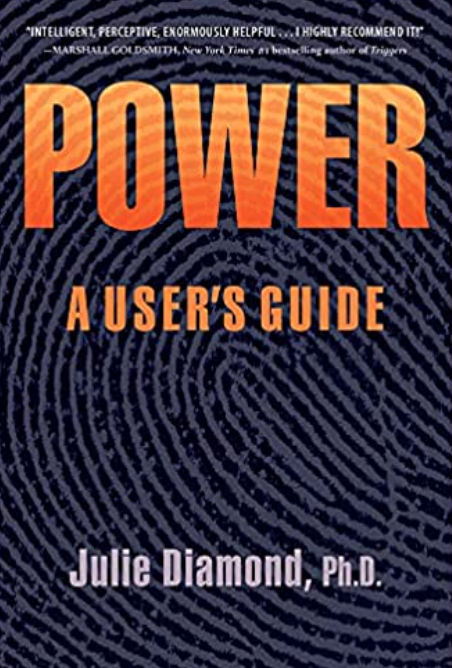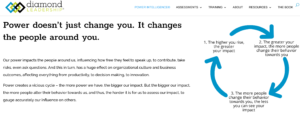This book, by Julie Diamond, PhD, was recommended to me by Shakil Choudhury, after reading his book, Deep Diversity, as part of the CIS Ontario Book Club. This is a natural next read, focussing on the individual’s relationship with power, providing meaningful questions, and an “PowerPrint” exercise.
You have this book in your hands because you wrestle with the
problems of leadership and power – whether you work in business, education, the nonprofit world… You askpire to be better at what you do, achieve more and have greater impact, but need to know how to navigate the [perils] of power first. (Diamond, 16)
The purpose of this book is to understand and then learn that power itself, is a skill to be learned. This book provides great tools, examples and reflections to help conceptualize power differently, to use power ‘well and wisely for the benefit of others and also for our own personal growth.” (Diamond, 199).
What I really appreciated about this book was that Julie Diamond, started as an educator, and her experiences and the importance of the role of educators is weaved throughout this book.
It truly is a guide – almost a workbook – that you can follow through, with exercises and a “PowerPrint” that will give you an artifact of yourself that you can then interrogate.
You would be interested in this book if you:
1) Are an educational leader, or aspiring leader, interested in moving beyond positional power, and understanding how to use your role and influence to improve your school;
2) Are in education, from a cultural-majority identity, who is looking to examine your practices of power, and how to become aware of your blindspots, areas of growth, and how to step into these areas of growth;
3) Are interested and engaged in the work of Diversity, Equity and Inclusion
4) Are exploring and change management through the lens of organizational culture
The Principles and Perils of Power
Formal power and Personal Power are explored, as is the relationship between these two forms of power. Diamond does this through her experience as an educator very well. She begins with her first iteration of power:
Power is our capacity to impact and influence the environment (Diamond, 3)
Point 1: This includes the power in omissions, in highlighting some voices over others, and neglect as well. And, while absolute power can corrupt absolutely, Diamond argues that this corruption is not inevitable. That, when we purposefully examine our personal and formal power roles / identities, we can use power for the greater good.
Point 2: Disinhibition is a peril of power – when in a higher rank, it ‘allows power users to act decisively when necessary, even when they lack all the pertinent information. But Disinhibition, while harmful, has many advantages, and can be associated with many cultural and societal breakthroughs – leaders not suffering from ‘analysis by paralysis’. (Diamond, 35)
Point 3: Power advantages results in a positive feedback loop – until it doesn’t. The more advantage one has based on their formal and / or personal power, the more likely they are to continually benefit from and build further power. However, the more power one has, the more (generally) one becomes aloof from those they have power over. This results in a loss of compassion and empathy, and understanding of those one has power over. This is particularly true in educational setting – a theme I dive into later on in this post.
Point 4: Power can be learned. As Diamond moves the read through this guide, she is constantly test and iterating on her definition of power. To counteract the principles and perils of power, individuals can adopt habits of mind, cultural practices and skills to move into their power with generosity and as a more effective leader.
Power isn’t a Hierarchy, It’s Personal…
Power is usually conceptualized as a triangle, with the most power residing at the top. In fact, even organizations that claim they are ‘flat’, still have hierarchy principles at work, that by denying it exists, leads to heightened conflict. Diamond proposes that power is a personal interconnected web (pg. 73)
In this interconnected web of power, intangible powers are just as
important as tangible ones. The social is just as meaningful as the personal. Think of power’s complex system as you would a fingerprint. Except in this case, it’s your Powerprint: an intricate patter of interconnected, overlapping, and sometimes contradictory capabilities and strengths. Like fingerprints, no two Powerprints are alike (Diamond, 72)
Being a very practical book, Diamond offers a very robust exercise in the appendix to work through and identify your own Powerprint – this is an incredibly telling exercise.
As an Educator, What I took from this Book:
As I said at the top, the author began her career as an educator, and this experience weaves its way throughout her anecdotes and her recommendations / strategies for using your power for positive outcomes.
– When you step into the role of teacher or even administration, you give up the notion of being ‘normal’, “because the rank and authority of your role magnify everything that you do. Being aware of this fact, or resisting it, can actually lead to a misuse of power.” (Diamond, 123)
– “The real work of leaders is teaching…People need to understand the rationale behind an agendas, and the urgency behind a decision.” (Diamond, 128) There has been a very fine balance between communicating well, and ‘dominating the airways’. It’s important to be clear and share the air amidst many important messages, but also to try and cut through the static of everyday complexities of education, without overwhelming or quieting the voices of others.
– If strategy eats culture for breakfast, as the saying goes, then make cultural improvement your strategy. “The people in your community play a greater role in your decision-making than any other factor. In other words, even if we are honest, law-abiding, and conscientious citizens, if we spend enough time in a given culture, we will come to view our behaviour through the lens of cultural norms.” (Diamond 142) If that is the case, how can we be sure to use our power to shift cultural norms and ways of behaving to promote the values and actions we want desire?
– Double Loop Learning is an exercise at the personal and organizational level. It means analyzing and reflecting on one’s own behaviours and actions in a way that generatively questions the underlying values and beliefs. Diamond then provides an example of a teacher who doesn’t believe in teaching to the test. “Jodie’s problem isn’t about failing to teach her students. It’s thinking that her standards are the only one’s that matter. Whether testing ‘works’ or not, the point is that test scores are data that her school must consider. Be engaging with, rather than ignoring that data, she should allow herself to be challenged and extend her thinking outside her belief system.” (Diamond 148). This example resonates with me, because I have been there. Being in a position of administrative power, I have to have a wider lens of understanding and context from the personal, classroom, organizational levels, all the way up to governmental levels. In my role, this extends even further to research within and beyond the educational sector – providing an even wider lens through which to look at the future we are graduating our students into. This context provides a better lens through which to exert power for positive outcomes, and allows one to stay grounded in decisions.
– Embrace your Low Rank: At some point in our career, or even at some point in a day, we will find ourselves in a lower rank of informal or formal power. Diamond encourages the reader to use this as a way to maintain and strengthen empathy and compassion. As we move up the formal hierarchy, there is ample research to prove an aloofness from those roles underneath: a lack of understanding and connection to the lived experience of these roles. However, by occupying these roles we can strengthen connection and understanding. For me, this equates to being an administrator who still teaches and coaches.
Wrapping up
This book covers much more than I have listed, and I can strongly recommend this book for anyone in the role of administration – the exercises, and provocative questions alone, make this a great read.
“My goal in writing this book was to demonstrate that power is learnable. Though reviled for its abuses, I believe that we can educate ourselves in it to be better leaders, better teachers, better parents. We can learn to use our powers well and wisely for the benefit of others, and also for our personal growth… So, as a user or power, first and foremost, forgive yourself. And then praise yourself for stepping forward and using your powerful gifts to make the world a better place.”


Thanks friend. Great review. I just ordered a copy.